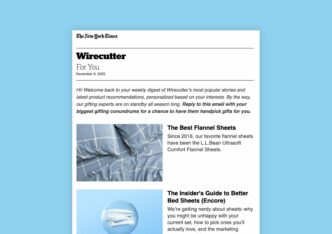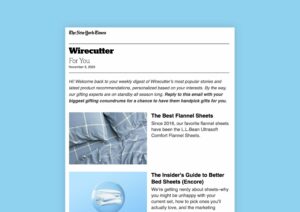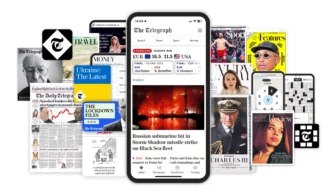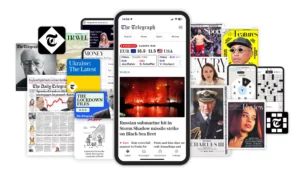
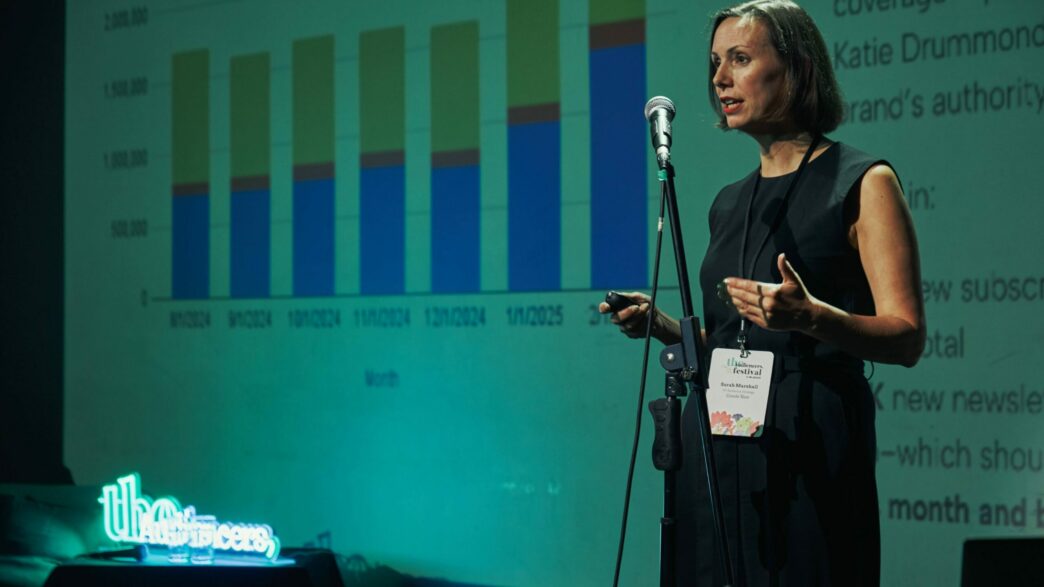
We had the pleasure of hearing from Sarah Marshall, VP, Audience Strategy at Condé Nast, at The Audiencers' Festival in London thanks to the invitation of our premium sponsor, WordPress VIP, the Open & Intelligent Experience Builder for modern enterprises.
Publishers are seeing significant declines in traditional top-of-funnel channels like Google search. “Ten blue links” – long associated with driving traffic – is becoming an anachronism as AI Overviews and AI mode outcompete outbound links to content producers.
We can’t influence search’s evolution or its impact on our visibility. That doesn’t mean abandoning user acquisition. It means prioritising what we can control: strategically engaging and retaining existing audiences.
According to Sarah Marshall, VP, Audience Strategy at Condé Nast, who spoke at The Audiencers’ Festival this June thanks to an invitation from WordPress VIP, the focus should be on cultivating the “happy middle”. We should turn the audience funnel from an inverted triangle (wide top, narrow bottom) into an inverted trapezoid (wider middle).
Here’s how she’s implementing this at Condé Nast …
Mapping channel strategy to the funnel
It’s important to understand which channels are in service of which phases of the audience funnel, especially the “happy middle” funnel phases of acquire, engage, and convert and retain.
This is the slide Sarah presented to editors and audience practitioners across Condé Nast brands to lay out their strategy for 2025:
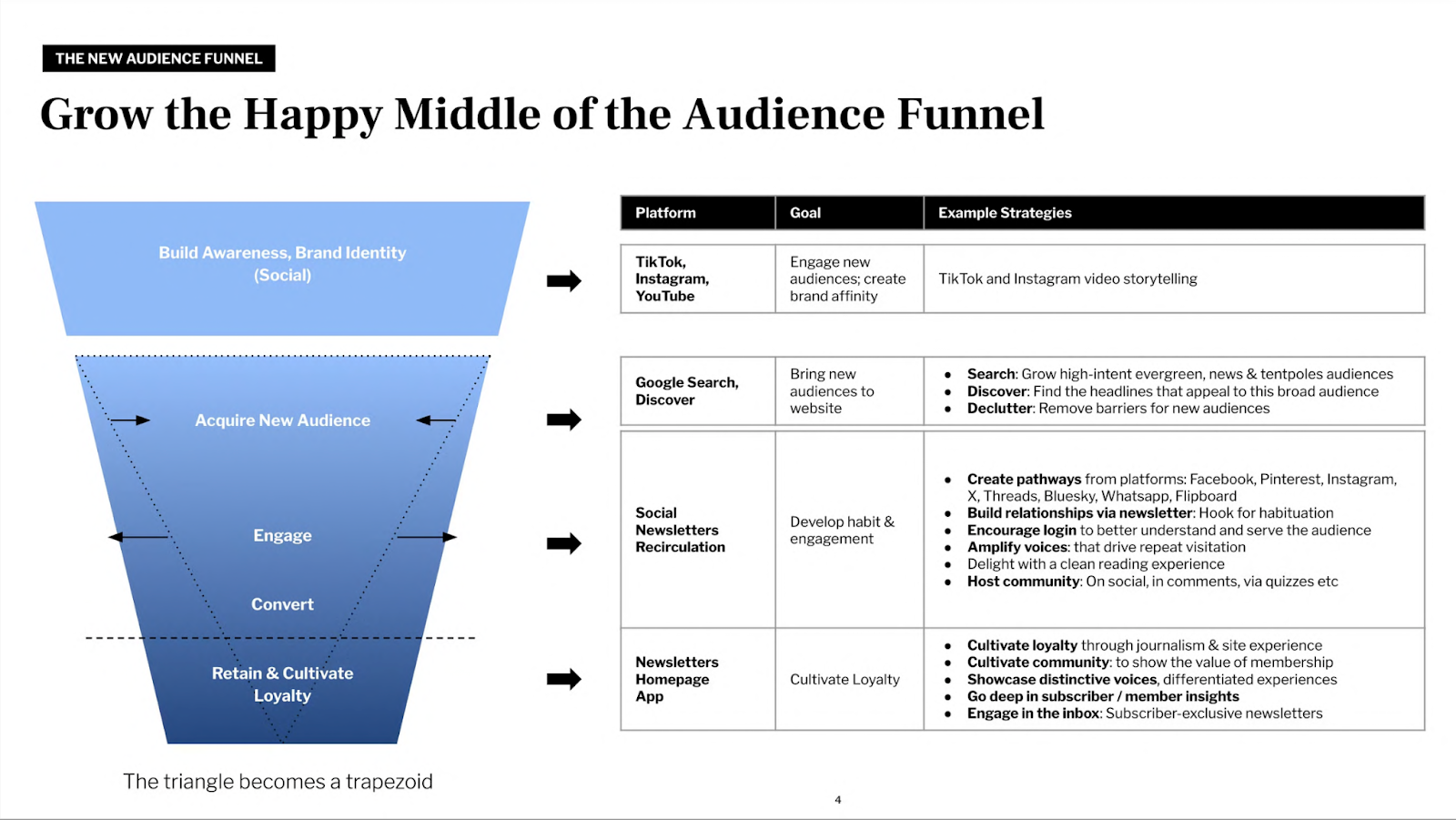
- To build awareness, YouTube and social channels like TikTok and Instagram have been key for Condé Nast. They’re meeting prospective audiences where they are.
- To acquire new users, Google search (and Discover) remains important despite declining effectiveness.
- To engage audiences, newsletters are a vital channel. Condé Nast, like most publishers, finds that newsletter subscribers are among their most engaged audiences.
- To retain audiences and cultivate loyalty, newsletters are again important, alongside homepages and apps.
Notice the intentionality here. Each channel has a specific job in the funnel. Rather than scattering efforts across channels hoping something sticks, Condé Nast strategically leverages them based on the value they provide across the audience funnel.
Mapping audience segments to the funnel
Delivering value across the audience funnel requires understanding their needs at different phases.
Condé Nast developed lifecycle stage segments to get this clarity: new audiences, returning audiences, and paying audiences.
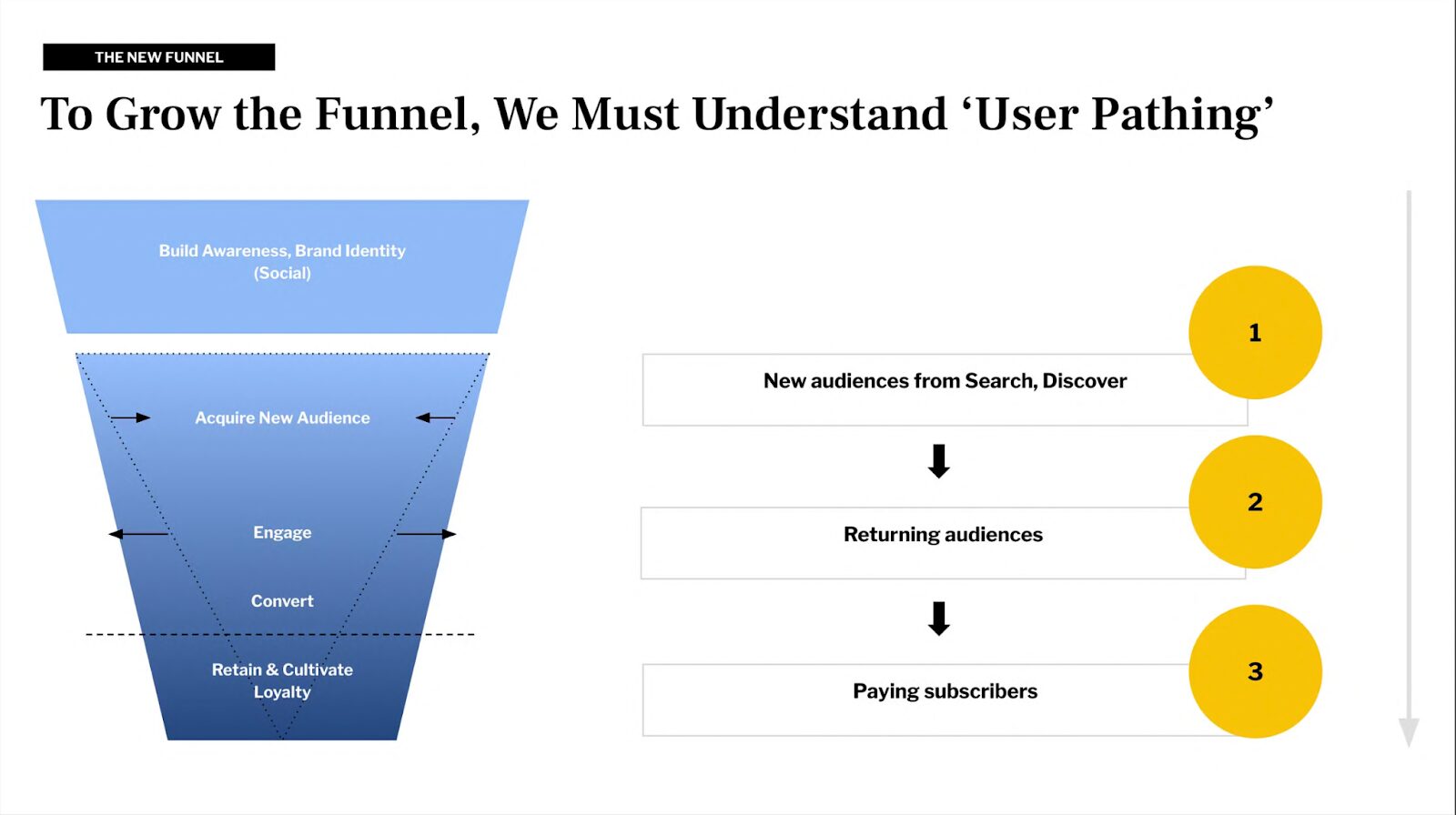
Through user pathing analysis, they’re identifying the levers that transition users from one segment to another, and cultivating the “happy middle”.
One lever is providing the right content for the right segments. They’re creating strategic content that serves the specific needs of segments, driving users from “new” to “returning” to “paying” by making those transitions feel natural and valuable.
Mapping content strategy to the funnel
Content serves specific stages of the funnel from awareness to the “happy middle” phases.
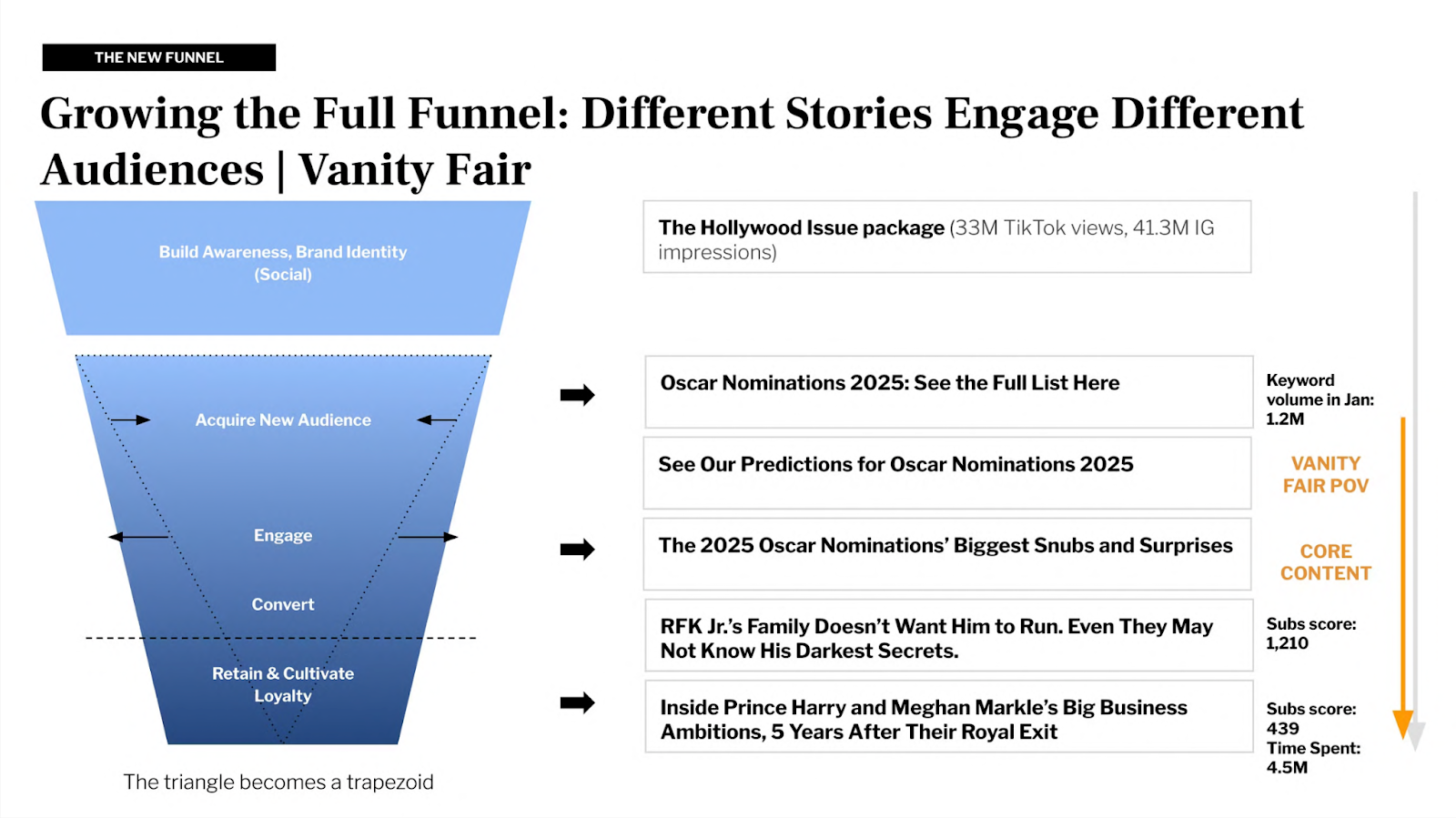
- To build brand awareness, video content is a winner, generating huge impressions from new audiences..
- To acquire some of these new, now-primed, audiences, a focus on high-intent evergreen content is working well. Condé Nast Traveler publishes content for key high-search-volume destinations, leading to growing Unique Pageviews (UPVs). Another tactic is ensuring headlines appeal to broad audiences of Google Discover.
- To engage their audiences, and form habits, quizzes have become a hit. As have galleries which deliver high Time Spent for Vogue.com. Audiences spent many millions of minutes on the gallery “See Every Look from the 2024 Met Gala”.
- To retain audiences and cultivate loyalty, distinctive journalism that provides value consistently is vital. Community engagement is also proving to be key. A live, subscriber-only, Q&A webinar from WIRED on how to make the most of ChatGPT attracted more than a thousand subscribers, 10% of whom subscribed to be able to tune into the webinar.
Content matters. But it walks hand in hand with good experiences. Even the best content strategy falls flat if the user experience is subpar.
Optimising site experience for engagement
Websites are becoming conversion magnets. They are increasingly seen as central to moving users to higher-value lifecycle stage segments. It is perhaps not surprising then that websites are cluttered with call-to-action pop-ups and access walls.
The issue is that these barely convert new audiences. In fact, they likely create bad experiences that make new audiences bounce.
Optimising for engagement means resisting optimising every pixel on the website for conversion. Instead, the focus should be on giving new audiences good, decluttered experiences that allow them to engage first, and then convert.
For Condé Nast, decluttering the experience involves:
- Prioritising the first viewport with a focus on the actual content
- Minimising cognitive load with few sticky elements
- Minimising friction to conversion
- No pop-ups
Improving newsletters continually
Newsletters are a high-value channel that drives both engagement and conversion. At Condé Nast, newsletter subscribers have the highest average UPVs.
Continuously optimising newsletter-audiences fit makes a lot of sense. Improvements have outsized effects downstream.
Condé Nast is overhauling its newsletter strategy to create:
- Better quality, stronger relationships with audiences
- Greater clarity about each newsletter’s potential to engage and convert subscribers
Some newsletters have untapped potential to focus on shopping. Vogue has already applied the audience funnel in service of commerce. It acquires new audiences with content that covers intent-searches like “best white t-shirts”, and then engages them with a storefront and a shopping newsletter. More newsletters focused on shopping, with an editorial voice, could supercharge this revenue stream.
Guaranteeing success
The success of Condé Nast lies in matching the right audiences (market) with the right content and experiences (product) through the right channels that sustain the right revenue streams (model).
It’s all interconnected:
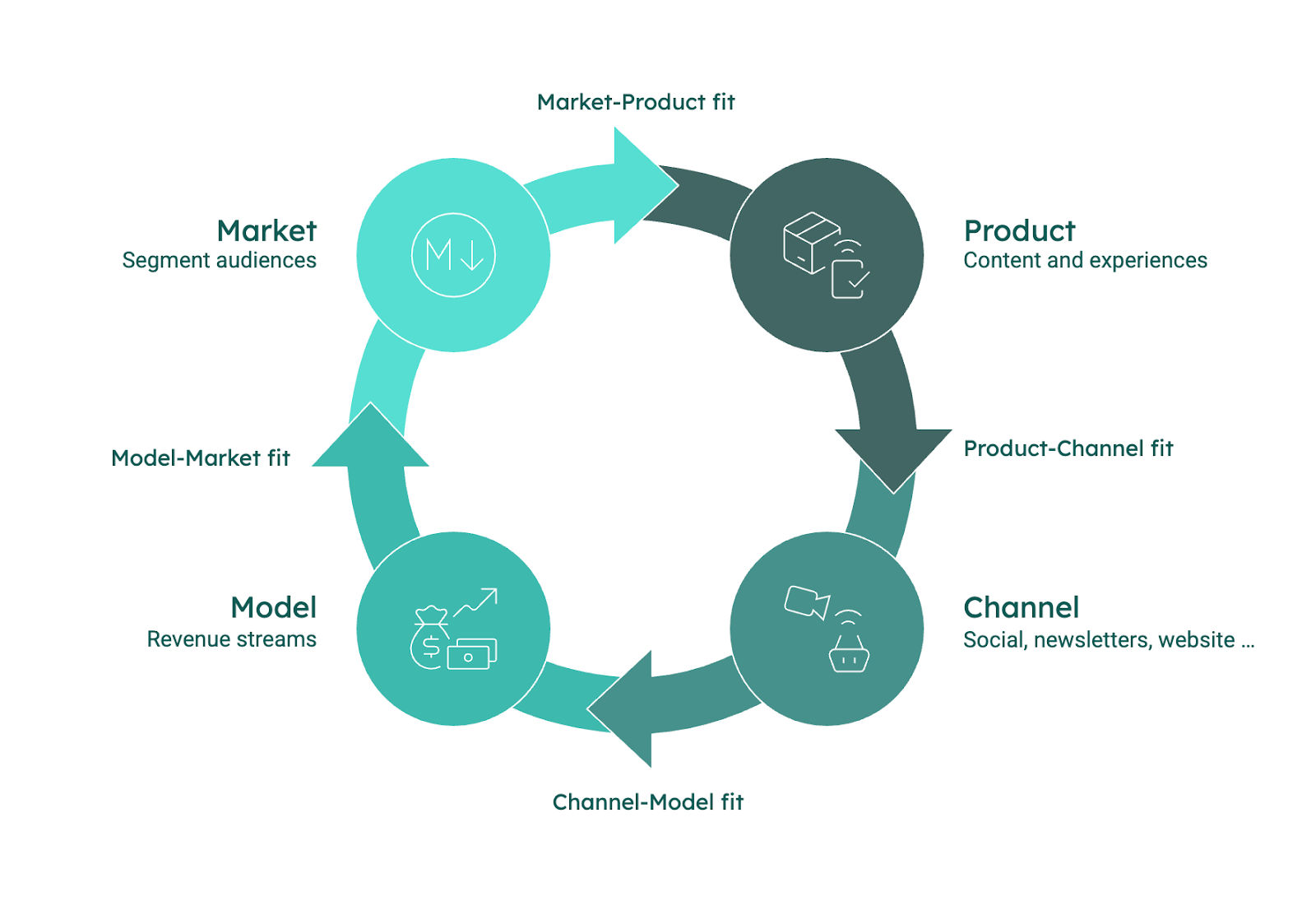
As you move beyond relying on top-of-funnel audiences to growing your “happy middle,” focus on achieving four fits:
- Market-Product fit: does your content, and experiences, genuinely serve your audience’s needs at their specific lifecycle stage?
- Product-Channel fit: are you delivering that content through channels best-suited to engaging you segment audiences?
- Channel-Model fit: do your chosen channels naturally support your revenue models?
- Model-Market fit: does your revenue approach align with your segment audiences’ ability to engage and spend?
Achieving these four fits explains why Condé Nast is doing so well. It is your guarantee to success. Your content feels essential, your channels feel natural, and your monetisation feels valuable rather than extractive.
Special thank you to WordPress VIP for supporting our Festival.
WordPress VIP is the Open & Intelligent Experience Builder for modern enterprises. It combines the ease and flexibility of WordPress—the CMS that runs 43% of the web. WordPress VIP pairs consumer-grade ease with enterprise-grade scale, security, and support.
Global leaders, including CNN, Salesforce, Bloomberg, NBC Universal, News Corp, Capgemini, and even The White House, trust WordPress VIP to publish at the speed of news, build dynamic digital experiences, and turn content data into growth.
WordPress VIP lets marketers and technologists move faster, collaborate better, and prove impact—without the heavy lift of legacy platforms.



